专四A talk 技巧
专题一Dictation-专四听写技巧

纵观2006-2015年的听写真题可以看出,材料选材范围比较广,包含社会生活, (Marriage-2015, Dreams-2013, Ecotourism-2012, Holidaying Habits-2011, New Year‘s Eve-2009, Advertising-07); 学习/教育 (Freshmen’s Week-2010, Choosing a Career-08); 科技 (Technology-2014, The Intemet-06)等各个方面。 就其趋势来看,选题越来越社会生活化,所采用的都是大家比较熟悉的话题。 而像02年、03年 (Salmon-03,Disappearing Forests-02)生物自然这 类专业性较强、生词较多的材料,后来就很少出现。因此,同学们在平时的听 写备考中就可先熟悉一些日常生活词汇或用语,而不需把重心放在生僻词汇或 话题上面。
13
B. Dictation听写技巧
1. 遭遇难点、有取有舍
评分不是依据写出的单词多少,而是看原文的主要意思是否表达清楚,所以, 遭遇难点时应注意: 1)如果遇到陌生词汇或发音熟悉但不会写的词,可用一些自己认识的缩略形式、 符号或音标先代替。 2)以意群为单位进行听写,因为一个意群最多扣一分。若有个别词或词组实在 反应不过来,也不要苦苦纠缠,必要时可舍弃一个意群,保证下一个意群。
17
C. Dictation听写难点
1. 拼写错误
➢注意容易拼写错误的词 英文复合名词通常由两个或两个以上的单词组成,这类复合名词的组成部分各 自也有其独立的意义,但构成复合词后两词需一起写或中间加连字符。但在考 试过程中,考生会因理解上的问题或其他原因将复合词写为两个词而犯错丢分, 如14年真题中的throughout易写成through out;woodland, farmland, countryside, 10年的well-respected易写成well respected。诸如此类 的词还有: (09) fireworks, the countdown(n.) , (07) sales-girls, well-organized, information-rich websites, online games等。
专四听力对话技巧

关于地点的提问形式通常为: Where does/did the conversation probably take place? Where are the man and woman speaking?
数字:one half/ a half; one and half; a quarter/ one fourth; five sixths; zero point five(0.5); one point five two(1.52); a couple of; million; billion。
第十七页,共49页。
货币:a dollar/ a buck; five cents/ a nickel; a dime 〔十美分 银币〕; a quarter/twenty-five cents; a pound; penny。 有关计算的表达:plus/add/addition〔加〕; minus/take off 〔减〕; multiply〔乘〕; divide〔除〕; double〔翻倍〕; triple〔增加到三倍〕; two more〔多两个〕; three less〔少 三个〕; half the price〔半价〕; thirty percent off/ discount of 30%〔打七折〕; at 15% discount〔打八五折〕。
专四听力
长对话,短文,新闻
第一页,共49页。
专四听力技巧-对话
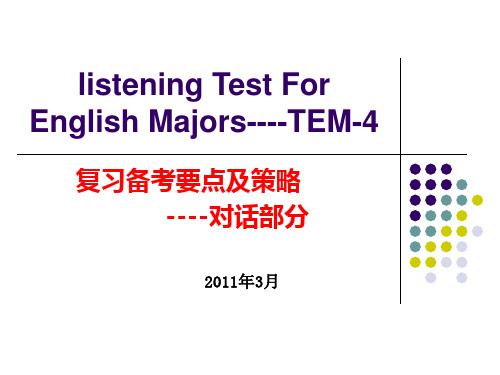
听力理解—对话(Conversations)
地点与方向题
表示地点场所的功能性词汇,与上述用于判断身份职业的关键 词是基本相同的。如:
School: assignment, lecture, paper, exam, campus, dorm, grades; (与上文Professor and student相对)
身份职业题
常见的身份、职业以及相关的词语和句子,如下表所列: Professor (teacher) and student
course freshman
assignment sophomore
graduation ceremony term paper
summer course
grade
undergraduate
常见的提问方式:
1. What is the main topic of the conversation? 2. What are the speakers mainly discussing? 3. What is the subject of this conversation? 4. What is the main idea of the conversation? 5. Which of the following best summarizes the conversation?
听力理解—对话(Conversations)
听力对话部分简介
(6)听力对话部分,考点位置分布比较均匀,需要考生在听 的过程中集中注意力,不可忽视任一小节的对话内容。
➢ 通常,位于对话中间的考点相对较多,占40%左右, 而极少的考点需要通篇理解全文才可作答。
➢ 从难度上来讲,材料开头和结尾的考点比较简单,而材 料中间和通篇理解的考点相对较难。这需要考生充分关 注听力材料的开头和结尾部分,因为那里往往都有考点 出现,所设题目也容易拿分。
《专四Atalk技巧》课件

掌握一些有效的练习方法,如模仿原生
提高Atalk能力
2
说话者的Atalk风格来提高自己的Atalk能 力。
利用练习来提高自己的Atalk能力,达到
更高水平的口语表达。
3
练习技巧
学习一些练习技巧,如录音自我评估, 加强对Atalk的掌握。
Atalk在口语考试中的应用
巧妙运用Atalk
学会巧妙地运用Atalk技巧,使自己的口语表达更加 生动、流畅。
提升口语表达
Atalk的运用可以帮助我们在口语考试中更好地表达, 提升口语成绩。
案例演示
Atalk的应用情境
举例解析Atalk的应用情境,展示Atalk对口语表达的 积极影响。
Atalk的提升效果
分析Atalk的运用对口语成绩的提升效果,了解Atalk 的重要性。
总结
Atalk的重要性和优势
总结Atalk的重要性和优势, 以及在专四考试中的作用。
Atalk的技巧
1 知道何时使用Atalk
学会判断何时使用Atalk,使口语表达更具魅力和效果。
2 达到自然流畅的效果
掌握使用Atalk的技巧,让自己的口语表达达到自然流畅的效果。
3 Atalk与语音语调的关系
了解Atalk与语音语调的关系,使口语表达更生动、有感染力。
Atalk的练习
1
练习方法
Atalk的实际应用及练 习方法
总结Atalk在实际口语应用中 的技巧和练习方法。
Atalk对口语成绩的积 极影响
总结Atalk对口语成绩的积极 影响,以鼓励学生加强Atalk 的学习。
《专四Atalk技巧》PPT课件
# 专四Atalk技巧 PPT课件 ## 概述 - 介绍Atalk的基本定义 - Atalk在专四考试中的作用
TEM 4 talk填空技巧

专四听力talk技巧专四听力理解部分为Talk填空和Conversations客观选择题,录音只听一遍!这部分也是大家普遍感到陌生并且很有难度的题型。
Talk部分是一篇讲座类型的文章,共10道填空题,长度约500个单词,考试时间10分钟,语速大约每分钟120个单词。
要求学生边听边做笔记,然后完成填空任务。
内容多为日常生活、社会生活和学习话题有关的演讲和会话。
1.预测对话内容,建立心理预期听力之前,会有30秒的时间快速浏览题目,这时候就可以大致看看这篇听力的话题,预测接下来的对话内容,对部分的填空也可以猜测应该填入的单词或词组的词性。
2.抓住主题,留意实词文章的开头和结尾部分通常都是对讲座主题的介绍的总述,从这里可以把握全文主旨大意。
一般需要填写的关键词多为实词,主要是名词、动词、形容词、或是一些细节性描述词汇。
3.表示顺序的词句后面是要点。
如First of all,...; The second point is...; Thirdly....; In conclusion,..等,这些词句后面的都是关键,都是关键,要记下来!4. 表示强调、重申的词句后是要点比如:one of the most important factor isThe essential point isTo put is another wayThat isIn other wordsOf course5. 逻辑关系词(转折、因果等)后是要点例如:however, but, in addition, consequently, therefore, in contrast, on the contrary, on the other hand等。
6. 表达观点的词句后是要点包括:believe, find, think, hold the view, according to等7. 表示举例的词句后是要点包括: for example, for instance, such as, namely, that is等。
talk做题技巧

talk做题技巧Talk部分是2016专四专八改革后的新题型,跟雅思题有点像,看起来复杂其实并不难。
做题的时候语音会播放答题指示,什么你有30秒提前看看题,最后有两分钟整理答案什么的,这个时候就不要听他讲了,直接看题,划关键词出来。
Talk选的文章都有清晰的脉络,一二三四数下来的不在少数,只要跟着节奏听下来就没问题。
关键词就主要看1 2 3后面的名词,也就是出题点,听到出题点的时候一定要警觉起来了,答案马上就要来了。
而且,当一个答案过去了,另一个答案一定不会在下一秒就跑出来,中间肯定会再磨叽几秒,所以不用太着急,要确保你听到的这个答案你已经记下来了。
如果有很长一段时间没听到答案,却发现后面的关键词已经出来了,那90%你已经漏听了一个题,这个时候不用紧张,赶紧跳到后面去,跟上节奏,不然后面的题就都没戏了。
其实做题步骤很简单了,无非是提前读题-划关键词-跟着节奏听-写-检查拼写、大小写和语法。
很多考生失分是在不会拼写上,在不断背单词的基础上,多试试自然拼读法,多练习,听到不会写的词时候不要着急查字典,按自然拼读法自己拼一下。
英语专业大二了,阅读量基本上都能保证你见过这些词,听音写出来词之后看看顺眼不顺眼,自己看着都不顺眼那一定写错了。
专四听写不会考那些你见都没见过一面的生僻词的。
最后写完了,剩下两分钟的时候,一定要仔细检查大小写、拼写和语法。
有时候你听到的是名词,但是整句被paraphrase了,所以你填写的词性可能也要变化了,所以这个时候一定要大胆更改。
复习的根本大法,还是多做题、多练习,每天一篇dictation保持住,dictation都不在话下的话,talk 简直小菜一碟。
刷题的时候,遇到不会的词,记下来,多复习。
多看看这种高频词比背词典有效多了。
相信自己,实在不会就懵个词写上去,万一要是对了呢!千万放轻松,有时会有考生一紧张,什么都没听到,然后更紧张了,整个专四就泡汤了。
专四A talk 技巧

2008
(2) 熟悉讲座常见的话语标记(十二类) Introducing 介绍/导入 Giving background information 交代背景 Defining 定义 Listing 列举 Giving examples 举例 Emphasizing 强调 Clarifying/Explaining 解释 Moving on/Changing direction 承接/转接 Giving further information 递进 Giving contrasting information 转折 Classifying 分类 Concluding 总结
I want to stress I’d like to put emphasis on It’s important to remember that We should bear in mind that Don’t forget that The essential point is
21
(2) 熟悉讲座常见的话语标记 Clarifying/Explaining 解释
12
讲座的结构实例分析 ——2008 (3)
Summary 总结 “Now, to sum up, in today’s lecture, we have reviewed some of the reasons…”
Closing 收尾 “OK, this brings us to the end of today’s lecture. Thank you for your attention. ”
英语专四、专八听力新闻听力特定词汇、听力技巧
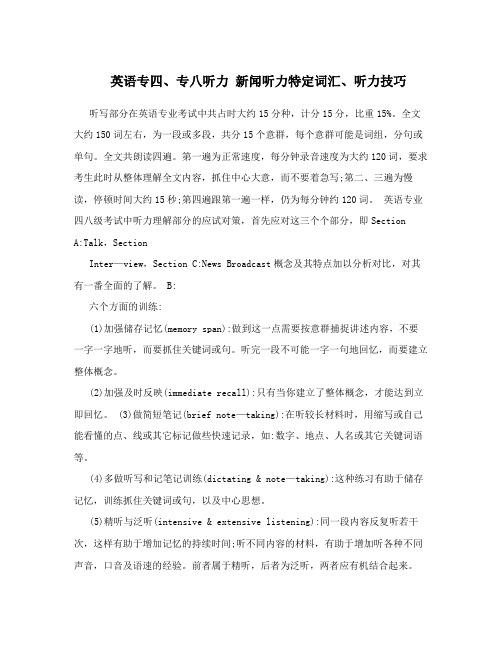
英语专四、专八听力新闻听力特定词汇、听力技巧听写部分在英语专业考试中共占时大约15分种,计分15分,比重15%。
全文大约150词左右,为一段或多段,共分15个意群,每个意群可能是词组,分句或单句。
全文共朗读四遍。
第一遍为正常速度,每分钟录音速度为大约120词,要求考生此时从整体理解全文内容,抓住中心大意,而不要着急写;第二、三遍为慢读,停顿时间大约15秒;第四遍跟第一遍一样,仍为每分钟约120词。
英语专业四八级考试中听力理解部分的应试对策,首先应对这三个个部分,即Section A:Talk,SectionInter—view,Section C:News Broadcast概念及其特点加以分析对比,对其有一番全面的了解。
B:六个方面的训练:(1)加强储存记忆(memory span):做到这一点需要按意群捕捉讲述内容,不要一字一字地听,而要抓住关键词或句。
听完一段不可能一字一句地回忆,而要建立整体概念。
(2)加强及时反映(immediate recall):只有当你建立了整体概念,才能达到立即回忆。
(3)做简短笔记(brief note—taking):在听较长材料时,用缩写或自己能看懂的点、线或其它标记做些快速记录,如:数字、地点、人名或其它关键词语等。
(4)多做听写和记笔记训练(dictating & note—taking):这种练习有助于储存记忆,训练抓住关键词或句,以及中心思想。
(5)精听与泛听(intensive & extensive listening):同一段内容反复听若干次,这样有助于增加记忆的持续时间;听不同内容的材料,有助于增加听各种不同声音,口音及语速的经验。
前者属于精听,后者为泛听,两者应有机结合起来。
(6)训练听与寻找答案同时进行(looking for the right answer while listening):在听的同时迅速浏览各项选择,只需细看各项选择的不同部分,而相同的部分只看第一个即可,这样可以节省时间以便多做思考。
新题型专四talk技巧25页PPT
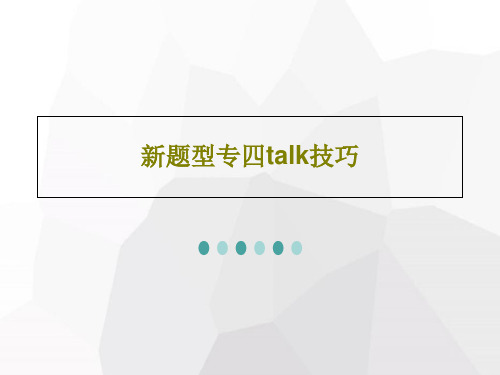
END
新题型专四talk技巧
16、业余生活要有意义,不要越轨。——华盛顿 17、一个人即使已登上顶峰,也仍要自强不息。——罗素·贝克 18、最大的挑战和突破在于用人,而用人最大的突破在于信任人。——马云 19、自己活着,就是为了使别人过得更美好。——雷锋 20、要掌握书,莫被书掌握;要为生而读,莫为读而生。——布尔沃
6、法律的基础有两个,而且只有两个……公平和实用。——伯克 7、有两种和平的暴力,那就是法律和礼节。——歌德
8、法律就是秩序,有好的法律才有好的秩序。——亚里士多德 9、上帝把法律和公平凑合在一起,可是人类却把它拆开。——而变得规矩起来。——德谟耶克斯
2017专四talk评分标准

2017专四talk评分标准2017专四talk评分标准是考生备考专四口语考试时需要了解和掌握的重要内容之一。
口语考试作为专四考试的一部分,对于考生来说具有非常重要的意义。
了解评分标准可以帮助考生更好地备考,提高口语表达能力,从而取得更好的成绩。
首先,评分标准要求考生的语音语调要准确、自然。
这就要求考生在口语表达时要注意语音的准确性,避免发音不清晰或者语调不自然的情况。
同时,要求考生表达时要有一定的语速和语音的流畅性,不要出现口齿不清或者结巴的情况。
其次,评分标准要求考生的词汇和语法要准确。
考生在口语表达时要尽量避免使用错误的词汇和语法,要有一定的词汇量和语法掌握能力,避免出现频繁的词汇和语法错误,从而影响口语表达的准确性和流畅性。
另外,评分标准还要求考生的语言表达要清晰、连贯。
这就要求考生在口语表达时要有清晰的思路和逻辑,避免出现语言表达混乱或者思路不清晰的情况。
同时,要求考生在口语表达时要有一定的连贯性,不要出现语言表达中断或者跳跃的情况,要保持表达的连贯性和完整性。
最后,评分标准还要求考生的语言表达要具有一定的语言表达能力和语言应变能力。
这就要求考生在口语表达时要能够灵活运用所学的词汇和语法知识,能够应对不同的口语话题和语境,避免出现语言表达僵化或者应变能力不足的情况,从而影响口语表达的质量。
综上所述,2017专四talk评分标准对考生的口语表达能力提出了较高的要求,考生在备考口语考试时需要充分了解和掌握评分标准,有针对性地进行口语训练,提高口语表达能力,从而取得更好的口语考试成绩。
希望考生们能够在备考过程中充分发挥自己的潜力,取得理想的成绩。
英语专业四级口试应考技巧
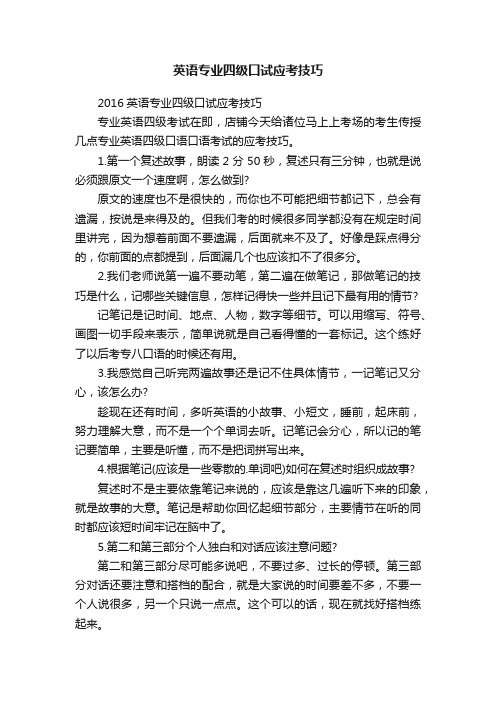
英语专业四级口试应考技巧2016英语专业四级口试应考技巧专业英语四级考试在即,店铺今天给诸位马上上考场的考生传授几点专业英语四级口语口语考试的应考技巧。
1.第一个复述故事,朗读2分50秒,复述只有三分钟,也就是说必须跟原文一个速度啊,怎么做到?原文的速度也不是很快的,而你也不可能把细节都记下,总会有遗漏,按说是来得及的。
但我们考的时候很多同学都没有在规定时间里讲完,因为想着前面不要遗漏,后面就来不及了。
好像是踩点得分的,你前面的点都提到,后面漏几个也应该扣不了很多分。
2.我们老师说第一遍不要动笔,第二遍在做笔记,那做笔记的技巧是什么,记哪些关键信息,怎样记得快一些并且记下最有用的情节?记笔记是记时间、地点、人物,数字等细节。
可以用缩写、符号、画图一切手段来表示,简单说就是自己看得懂的一套标记。
这个练好了以后考专八口语的时候还有用。
3.我感觉自己听完两遍故事还是记不住具体情节,一记笔记又分心,该怎么办?趁现在还有时间,多听英语的小故事、小短文,睡前,起床前,努力理解大意,而不是一个个单词去听。
记笔记会分心,所以记的笔记要简单,主要是听懂,而不是把词拼写出来。
4.根据笔记(应该是一些零散的.单词吧)如何在复述时组织成故事?复述时不是主要依靠笔记来说的,应该是靠这几遍听下来的印象,就是故事的大意。
笔记是帮助你回忆起细节部分,主要情节在听的同时都应该短时间牢记在脑中了。
5.第二和第三部分个人独白和对话应该注意问题?第二和第三部分尽可能多说吧,不要过多、过长的停顿。
第三部分对话还要注意和搭档的配合,就是大家说的时间要差不多,不要一个人说很多,另一个只说一点点。
这个可以的话,现在就找好搭档练起来。
6.其他的一些需要注意的地方?不要紧张。
注意语音语调。
7.一下面一篇文章为例,该记哪些关键词?In 1908 Lord Northcliffe offered a prize of 1000 pounds to the first man who would fly across the English Channel. Over a year passed before the first attempt was made. On July 19th,1909, in the early morning, Hubert Latham took off from the French coast in his plane the "Antoinette 4". He had travelled only seven miles across the channel when his engine failed and he was fored to land on the sea. The "Antoinette" floated on the water untill Latham was picked up by a ship.Two days later, Louis Bleriot arrived near Calais with a plane called "No.11". Bleriot had been making planes since 1905 and this was his latest model. A week before, he had completed a successful overland flight during which he covered twenty-six miles. Latham, however, did not give up easily. He, too, arrived near Calais on the same day with a " Antoinette". It looked as if there would be an exciting race across the channel. Both planes were going to take off on July 25th, but Latham failed to get up early enough. After making a short test flight at 4.15 a.m, Bleriot set off half an hour later. His great flight lasted 37 minutes. When he landed near Dover, the first person to greet him was local policeman. Latham made another attempt a week later and got withing half a mile of Dover, but he was unlucky again. His engine failed and he landed on the sea for the second time.7.关键词1908 Lord Northcliffe prize 1000 pounds first fly En Channel.a y7 19,1909 early morning, Hubert Latham French coast "Antoinette 4".seven miles engine failedland on sea.floated untill a ship.参考答案Two days later, Louis Bleriot Calais "No.11".making planes since 1905 latest model.A week before, successful overland flight twenty-six miles.L not give up easily near Calais same day " An". as if exciting raceBoth off 7 25, L failed to get up early enough.After short test 4.15 a.m, B set off half an hour later. lasted 37 minutes.landed near Dover, first greet him local policeman. L another attempt a week laterwithing half a mile of Dover, but unlucky again. engine failed sea second time.。
专四英语口语考试技巧
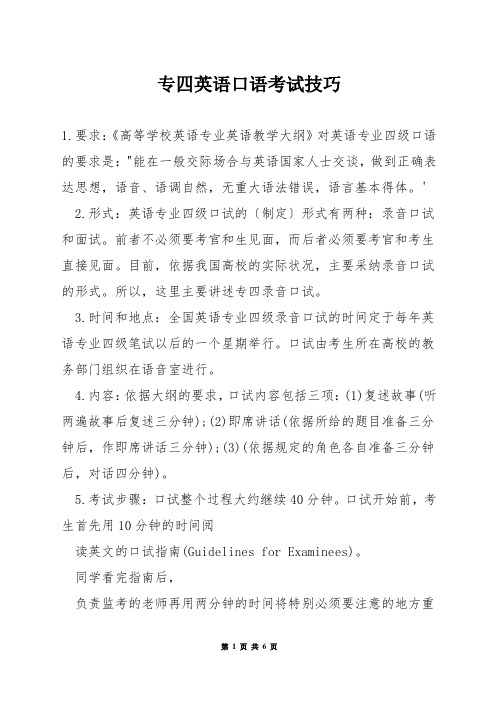
专四英语口语考试技巧1.要求:《高等学校英语专业英语教学大纲》对英语专业四级口语的要求是:"能在一般交际场合与英语国家人士交谈,做到正确表达思想,语音、语调自然,无重大语法错误,语言基本得体。
'2.形式:英语专业四级口试的〔制定〕形式有两种:录音口试和面试。
前者不必须要考官和生见面,而后者必须要考官和考生直接见面。
目前,依据我国高校的实际状况,主要采纳录音口试的形式。
所以,这里主要讲述专四录音口试。
3.时间和地点:全国英语专业四级录音口试的时间定于每年英语专业四级笔试以后的一个星期举行。
口试由考生所在高校的教务部门组织在语音室进行。
4.内容:依据大纲的要求,口试内容包括三项:(1)复述故事(听两遍故事后复述三分钟);(2)即席讲话(依据所给的题目准备三分钟后,作即席讲话三分钟);(3)(依据规定的角色各自准备三分钟后,对话四分钟)。
5.考试步骤:口试整个过程大约继续40分钟。
口试开始前,考生首先用10分钟的时间阅读英文的口试指南(Guidelines for Examinees)。
同学看完指南后,负责监考的老师再用两分钟的时间将特别必须要注意的地方重复一遍。
如向考生强调整个考试期间他们都不同意按动自己录音机上的任何一个键,考试内容都已经录在磁带上。
考试正式开始后,考生依据录音磁带上的要求依次完成三项任务。
录音的操作完全由监考老师控制。
2通过专四口语考试的技巧1)方法:a.聊天前做好主题准备工作,包括了解话题、查找所涉及的单词、准备能套几十个常用句型备用。
b.身上装上一本15000词左右的英汉小词典和一本1万词条左右的汉英小词典。
c.聊天过程中不要怕在对方面前查字典。
无关紧要的话可以设法用其它句子说清楚,关键的词则一定要查字典。
d.聊完天后应对从今天聊天中学到的单词、表达法、句型进行登记总结,并背下来。
2)注意事项:a.复习预习工作一定要做,只有这样每一次聊天才会有较大的收益。
b.不要怕丢面子。
2023年英语专四对话与短文应试策略

英语专四对话与短文应试策略对话:对话命题重要题型:1.场景题型:此题型涉及到地点、人物、时间等基本题型。
1)考察地点题型:形式有两种,猜测地点和判断地点,常见提问方式有Where does this conversation probably take place?Where did it happen?Where is…?What kind of the store is she visiting?2)考察时间题型:形式有两种,一是从多个时间中选一个时间;二是通过运算求得时间。
常见提问方式有When does this conversation take place?When does the man want to leave?How long did it take the man to write his paper?When did the football match start?3)考察人物关系题型:常见提问方式有What is the probable relationship between the two speakers?2.事实题型:重要考察具体环境的某些特定事实和行为。
常见的提问方式有What does the man mean by…?What does the man say about…?What will the man probably do?在专四的对话听力考试题型中,常见的题型涉及考察行为、考察行为特性和考察事物特性等重要形式。
1)考察行为(例如:2023真题Conversation 1)Man: I think I will drop in the day after tomorrow to check out.3.What will Mark Adams do the day after tomorrow?A. To come to the office again.B. To wait for the phone call.C. To call the office.D. To write to the office.2) 考察行为特性(例如:2023真题Conversation 2)M: Right, this is the tennis club reception area. As a member, you don’t have to register when you arrive, but you must remember to register your guests. And you must be able to produce your membership card if a club official asks to see it.4. Members of the club are required toA. register when they arrive.B. bring up to three guests.C. register their guests.D. show membership cards on arrival.3)考察事物特性(例如:2023真题Conversation 3)M: I went to Manchester University and got an engineering degree with management as my specialization.8. At the university Mr. Robinson specialized inA. math.B. physics.C. water managementD. geography.3. 推导题型:在专四的对话听力考试题型中,常考察的推导题型涉及: 考核对话意图、考察评价、考察因素等题型。
新题型专四talk技巧25页PPT

6、最大的骄傲于最大的自卑都表示心灵的最软弱无力。——斯宾诺莎 7、自知之明是最难塞内加 9、有时候读书是一种巧妙地避开思考的方法。——赫尔普斯 10、阅读一切好书如同和过去最杰出的人谈话。——笛卡儿
Thank you
1、不要轻言放弃,否则对不起自己。
2、要冒一次险!整个生命就是一场冒险。走得最远的人,常是愿意 去做,并愿意去冒险的人。“稳妥”之船,从未能从岸边走远。-戴尔.卡耐基。
梦 境
3、人生就像一杯没有加糖的咖啡,喝起来是苦涩的,回味起来却有 久久不会退去的余香。
新题型专四talk技巧4、守业的最好办法就是不断的发展。 5、当爱不能完美,我宁愿选择无悔,不管来生多么美丽,我不愿失 去今生对你的记忆,我不求天长地久的美景,我只要生生世世的轮 回里有你。
英语专业四级口语流利技巧
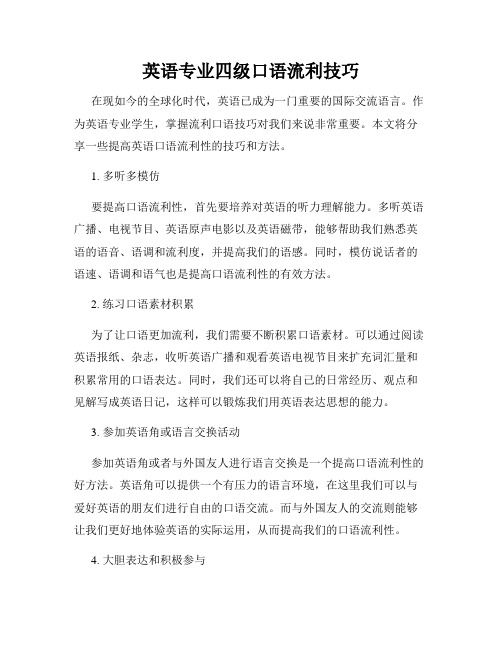
英语专业四级口语流利技巧在现如今的全球化时代,英语已成为一门重要的国际交流语言。
作为英语专业学生,掌握流利口语技巧对我们来说非常重要。
本文将分享一些提高英语口语流利性的技巧和方法。
1. 多听多模仿要提高口语流利性,首先要培养对英语的听力理解能力。
多听英语广播、电视节目、英语原声电影以及英语磁带,能够帮助我们熟悉英语的语音、语调和流利度,并提高我们的语感。
同时,模仿说话者的语速、语调和语气也是提高口语流利性的有效方法。
2. 练习口语素材积累为了让口语更加流利,我们需要不断积累口语素材。
可以通过阅读英语报纸、杂志,收听英语广播和观看英语电视节目来扩充词汇量和积累常用的口语表达。
同时,我们还可以将自己的日常经历、观点和见解写成英语日记,这样可以锻炼我们用英语表达思想的能力。
3. 参加英语角或语言交换活动参加英语角或者与外国友人进行语言交换是一个提高口语流利性的好方法。
英语角可以提供一个有压力的语言环境,在这里我们可以与爱好英语的朋友们进行自由的口语交流。
而与外国友人的交流则能够让我们更好地体验英语的实际运用,从而提高我们的口语流利性。
4. 大胆表达和积极参与要想提高口语流利性,我们要敢于表达自己的观点和想法,并积极参与口语练习。
在课堂上,我们可以积极回答老师的问题,和同学进行小组讨论。
在日常生活中,我们也要尝试用英语与他人进行交流,不要害怕犯错误,积极尝试才能提高口语流利性。
5. 注意语音语调和连词的使用在提高口语流利性的过程中,我们还需要关注语音语调和连词的使用。
语音语调决定了我们的发音和语速,要注意模仿标准的英语发音,并通过练习来提高发音的准确性。
另外,连词的使用也能够使我们的表达更加流畅。
我们可以使用一些常见的连词,如"however"、"therefore"和"meanwhile"等,来连接句子和段落,使文章或者对话更具连贯性。
总结起来,提高英语专业四级口语流利性需要多听多模仿、积累口语素材、参加英语角或语言交换活动、大胆表达和积极参与口语练习,以及注意语音语调和连词的使用。
- 1、下载文档前请自行甄别文档内容的完整性,平台不提供额外的编辑、内容补充、找答案等附加服务。
- 2、"仅部分预览"的文档,不可在线预览部分如存在完整性等问题,可反馈申请退款(可完整预览的文档不适用该条件!)。
- 3、如文档侵犯您的权益,请联系客服反馈,我们会尽快为您处理(人工客服工作时间:9:00-18:30)。
PRACTICE
Please identify the following parts in the manuscript of Section A Talk in TEM4-2016 Opening 开场白 Thesis 主题 Connection 承接 Body 正文 Summary 总结 Closing 收尾
8
2.1 关键信息题型 二级要点:讲座提纲的次要节点/小标题 二级要点在一级要点之下,一般是列举、阐述、解 释、分类等细节信息;题目很直观,解题有赖于认 真仔细的记录和准确记忆
II. Types of Information A. Information in history is (2)_______
“Then, actually how many people speak Englind ’ language…”
11
讲座的结构实例分析 ——2008 (2) Body 正文 “Then, we may ask a question…” “First is the historical reason… ” “Now, the second major factor… ” “And the third factor related to the popular use of English is …” “Another factor has something to do with information exchange …” “The last factor I cite here concerns popular culture…”
As we know As we have already seen As we have all read It’s clear that It goes without saying We all understand It is understood You’ll remember
17
(2) 熟悉讲座常见的话语标记 Defining 定义
24
(2) 熟悉讲座常见的话语标记 Giving contrasting information 转折
Although However On the other hand Whereas Despite Nevertheless But Alternatively
2014 How to Reduce Stress( 通识)
2015 Understanding Academic Lecture(学习)
2016 What is Grit(通识)
5
1. 考试介绍 文体特点: 讲座文体正式(但话语标记有时正式有时非正式), 语言规范,逻辑严密,结构分明; 含有专业名词或术语(e.g. lingua franca ); 时间分配(一般): 8分钟左右讲座(边听边记录) 2分钟检查笔记
In other words, That is to say, To put it another way, By which I mean Or you could say The point I’m making is That is, Namely, i.e. That means It turns out that
(2) 熟悉讲座常见的话语标记(十二类) Introducing 介绍/导入 Giving background information 交代背景 Defining 定义 Listing 列举 Giving examples 举例 Emphasizing 强调 Clarifying/Explaining 解释 Moving on/Changing direction 承接/转接 Giving further information 递进 Giving contrasting information 转折 Classifying 分类 Concluding 总结
23
(2) 熟悉讲座常见的话语标记 Giving further information 递进
Furthermore, Another point A further point In addition / Moreover / Similarly Apart from, Not only …, but We can add / I could add that Further / As well as / Besides
15
(2) 熟悉讲座常见的话语标记 Introducing 介绍/导入
Today,what I intend to say is Today, what I’d like to do is to discuss Today, what I intend to do is to explain In my talk today, / my topic today is
Today, I’m going to talk about Today, I’m going to talk to you about In this talk, I would like to concentrate on Today,the subject of this talk is
Indirect Way: I think as seniors, you are often
12
讲座的结构实例分析 ——2008 (3)
Summary 总结 “Now, to sum up, in today’s lecture, we have reviewed some of the reasons…”
Closing 收尾 “OK, this brings us to the end of today’s lecture. Thank you for your attention. ”
is is called X is known as may be defined as is a type of Y that/which
18
(2) 熟悉讲座常见的话语标记 Listing 列举
Firstly Secondly Next Then Thirdly Lastly Finally
I want to stress I’d like to put emphasis on It’s important to remember that We should bear in mind that Don’t forget that The essential point is
21
(2) 熟悉讲座常见的话语标记 Clarifying/Explaining 解释
required by your instructors to do some library
research on this topic or that, and in the end, you
have to write a research paper. 2004
16
(2) 熟悉讲座常见的话语标记 Giving background information 交代背景
First of all In the first place For one thing To begin with In the second place For another thing
The first/second/
next/last point I’d like to
make is
19
II. Reasons for the popular use of English 1) (3) 2) Economic reasons; 3) (6) in international travel; 4) Information exchange; 5) Popular culture;
2008
设计:一篇500字长度的微型讲座和一项填空任务,要求 考生边听边做笔记,然后完成10题填空;填空以提纲形式 出现。
3
1. 考试介绍
选材特点:自2004新大纲后以“英语专业知识和通识课程” 为选题内容
2005 Writing a Research Paper (科研) 2006 Meaning in Literature (文学) 2007 What Can We Learn from Art? (艺术) 2008 The Popularity of English (语言) 2009 Writing Experimental Reports (科研)
10
讲座的结构实例分析 ——2008 (1)
Opening 开场白:
“Good morning, everyone.”
Thesis 主题:
“Today‘s lecture is about the popularity of English.”
Connection 承接:
“Although English is NOT the language with the largest number of native or “first” language speakers, ...what is a lingua franca? The term refers to…”
6
2. 题型分析 2.1 关键信息题型* 一级要点:讲座提纲的大标题 二级要点:讲座提纲的小标题 2.2 推理判断题型** 根据听到的内容和记录的笔记推理而出,一般 会有多种正确答案 2.3 概括总结题型*** 在理解讲座原话的基础上进行概括、总结,有 一定难度
7
2.1 关键信息题型 一级要点:讲座提纲的主要节点/大标题 要点排列有序,此类题目一般笔记不遗漏要点就能 准确回答
(2) 熟悉讲座常见的话语标记 Giving examples 举例
For example, For instance, You only have to think of Remember, Say, Take something for example,
